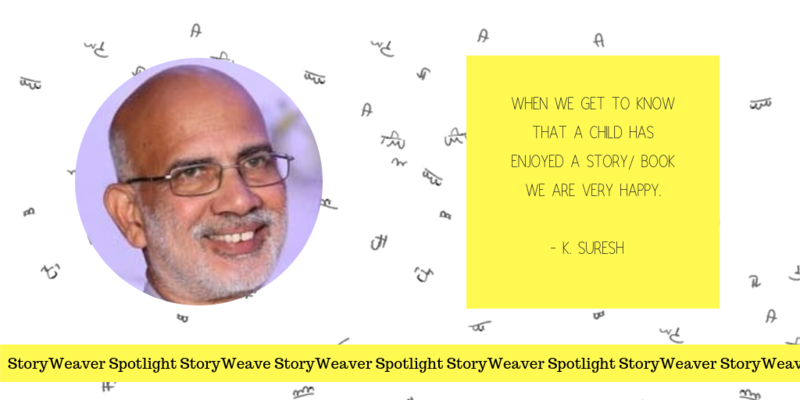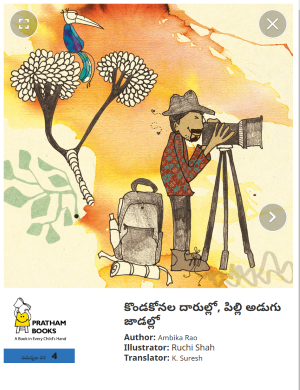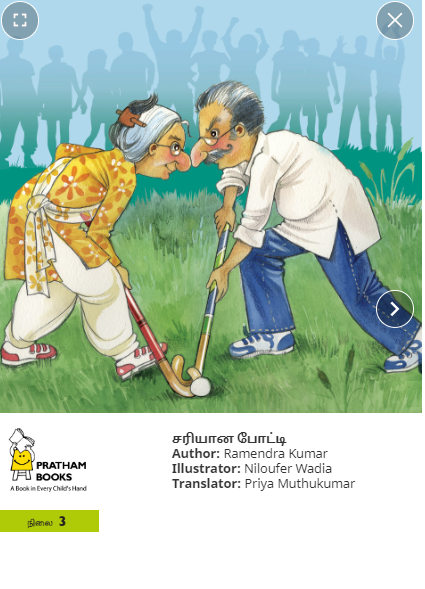StoryWeaver Spotlight: K. Suresh
Posted by Remya Padmadas on June 25, 2019K. Suresh likes to be known as a translator and has several books published for adults as well as children. He is one of the founders of Manchi Pustakam, a Trust for publishing and distributing children's books in Telugu. The organisation has more than 200 titles published by it and distributes an equal number of select books by other publishers. His emphasis is on books that create interest in and love for books among children. He feels that there is a great need for graded books that help children to increase their reading capacities. He has translated many stories to Telugu for Pratham Books including 'The Cat in the Ghat!' and 'What If?'. You can read his stories Mouse in the House and Lost and Found on StoryWeaver.

Q: What type of person do you think makes the best translator for children’s stories?
A person who loves books, likes children and respects them.
Q: Do you have any advice for anyone interested in becoming a translator?
A: The person should have good command over both the languages and should know the nuances. S/he should also know the cultural context and usage of idioms and phrases in both the languages. One should also read a lot.
The language for children should be simple. While translating one should use available vocabulary, though English words are commonly used. After completing the translation, give some gap and read it again without the source language text. Read it objectively, as if it was done by others and your job is to find errors in it.
Q: A book you'd like to recommend to other translators?
I suggest that the translators start with what they like and should feel that the children in the other language would miss a lot if that book isn’t translated. Obviously, I would suggest a book that I love very much.
Q: What is your personal relationship to language and/or translation?
I love to read books. I have started my work as a sub-editor in a Telugu newspaper, which involved translation and cultivated it over the years. I am not a creative writer, so I take pride in translation!
Q: When you’ve been given a story to translate, what’s your process, and how long does it generally take?
Sometimes I jump into translation. Sometimes, I read the entire story and sleep over it. While reading and in the free time, I think about the appropriate words and how it will be in Telugu.
Q: What do stories in translation bring to young readers?
It opens up their world! It introduces a new culture.
Q: You’ve translated stories for us. Which has been your favourite to work on?
I had the fortune of translating, reviewing and being a Guest Editor for Pratham Books. I liked translating The Cat in the Ghat!

Q: What is the hardest thing about translating from English into Telugu? How do you navigate words or phrases that are tricky to translate?
The structure of English sentence is complex; it can take several adjectives and be very long. Breaking the sentences while translating sometimes results in losing the emphasis. The rhyming and punning with English words is difficult to translate. After the first translation, I explore simpler expressions and choice of vocabulary.
Q: How do you feel when your story reaches the child?
When we get to know that a child has enjoyed a story/ book we are very happy.
Q: Translating stories must have required research when it came to STEM related terms and concepts. How did you explore new objects and concepts?
For some words, I look up the dictionary. Sometimes re-writing helps. Constant reading will add to one’s vocabulary.
Q: How else do you think we can join hands to take more stories to more children in more languages?
Pratham Books and Tulika are doing excellent job in multi-language publications. StoryWeaver is providing a platform for exchange of books in various languages. Arvind Gupta is encouraging multi-language translations of children’s books and posting them on internet archive. Earlier there was considerable direct translation in regional languages, now English has become the connecting language. A publishers’ consortium for exchange of rights would be beneficial.
Q: As a publisher and translator what do you think is the best way to approach a child?
The general tendency is to preach to children, which I do not subscribe to. We expect lot from children without practising/ following them. The best way is to make a range of books available to children from which they can choose. We should not be overly worried about what they learn from a book. They will definitely learn from books and the society at large.
Be the first to comment.
StoryWeaver Spotlight: Nivedha
Posted by Remya Padmadas on July 01, 2019Nivedha is a Physics graduate currently working in the field of education. She enjoys taking science to kids through stories. She has translated many stories to Tamil for Pratham Books including 'Talking in Twos' and 'This is How You Count Eggs'. You can read her stories The Girl Who Thinks in Numbers: Data Warrior Prukalpa Sankar and The Scavenger Hunt on StoryWeaver. 
Q: Can you tell us anything about yourself and your job that would surprise us :) ?
I am a mildly mischievous person with good observation skills. No wonder I chose to study science and became a physics graduate eventually. Now I work in an education-based organisation where I develop content for school kids. While designing language lessons, I try to include storytelling elements to it. It’s quite interesting!
Q: What is your personal relationship to language and/or translation?
Being a single child to my parents, books have been the biggest companion to me since childhood. I remember reading books even when I couldn’t understand the meaning of most parts of the text. Language feels like a cosy and comfortable space that my mind loves going to!
Q: When you’ve been given a story to translate, what’s your process, and how long does it generally take?
First, I read the story three to four times. During the initial reads, I consciously ignore the fact that I am reading it for the purpose of translation. It helps to grasp how a particular story might feel/appeal to a reader.
In the next step, I read about the region/culture where the story happens. For STEM stories I make sure that I revise/read the science concepts that are dealt with. This process I stretch across a few days to a week and when I sit to write it down it doesn’t take more than a few hours.
Q: In your opinion, what do stories in translation bring to young readers?
Children love exploring new things. These stories provide an exposure to other cultures and people. I believe it helps the kids to know about the differences existing among us or feel that it is okay to be different.
Q: How did you cultivate the skills needed to translate books for children?
Translation is relatively a new thing to me and I have a lot to learn. I read children stories and translated stories. Reading translation related discussions on digital platforms also help me. I also watch child centred cartoons like ‘Peppa Pig’ where an episode is like a visual short story of 5 minutes and then imagine how we can give similar experience through the text .
Q: What was the experience of translating a children’s book like, compared to translating for adults?
The exposure and worldview that a child has is very different from what an adult would have. So this has to be kept in mind too. Also, while translating for adults I feel there is a liberty to use slang, but for children had to go back to the basic words. During this process, I also learnt(had to learn) new words whose usage is not very common in spoken language.
Q: You are also a Physics graduate who loves the subject. How is the experience of translating STEM based stories? Are there any particular experiences/opinions from this experience?
I believe children grasp things quickly when it’s told as a story spun around their world and experiences. In that way, translating STEM based stories make me happy as it helps in taking science to kids in an interesting way.
Especially, while translating the story “The Scavenger Hunt”, I was delighted at how the basic concept of filtration was taken and woven into the story. When Lajjo (the main character) goes in search of tools, we could see that how a tool/object is accessed/placed varies for each culture. It gave me an insight that our interaction with the material world is not the same and thus teaching science in the same way to everyone may not work in all cases.

Q: What is the hardest thing about translating from English to Tamil? How do you navigate words or phrases that are tricky to translate?
I find translating the technical words/jargons to Tamil the hardest. Most times people would be familiar with the actual English terms than Tamil. In that case I refer to dictionaries, other tests and try to use an easier, relatable Tamil equivalent. I also cross check with my friends if they can understand that word/phrase.
Q: How else do you think we can join hands to take more stories to more children in more languages?
Book fairs are a great way to reach Children. The publications concentrating on children and young adult literature can collaborate and come up with a dedicated stall for them. (This from my experience in Chennai book fair. Though many kids come, availability of books in regional languages is not sufficient.)
This platform can also be used to attract talent who are interested in children’s literature.
Q: What type of person do you think makes the best translator for children stories?
Anyone who has a love for language and is open to learn from everyone and everything can make a good translator.
Q: Do you have any advice for anyone interested in becoming a translator?
I think I still am in a place to receive a lot of it? 😊 Anyways, I would say to be open to learning and observe the language of people around you. It helps a lot.
Q. A book you would recommend to other translators?
Eriyum panikkaadu (எரியும் பனிக்காடு) by R. Murugavel (Originally written in English by P.H.Daniel). I didn’t even have the slightest thought that ‘Eriyum panikkaadu’ could be a translated book when I first read it. Such was the flow of text in the translation. Isn’t that an aim of every translator!
Be the first to comment.StoryWeaver Spotlight: Priya Muthukumar
Posted by Amna Singh on September 28, 2018StoryWeaver Spotlight turns the light on Priya Muthukumar. Priya always dreamt of flying on her very own magic carpet! Yes, today she flies to several distant lands along with different people through her stories. Priya is a storyteller and educationist who connects with people across age-groups through her storytelling initiative (Storipur in Bangalore). She continues to dream, this time.. about a greener tomorrow! She has translated many stories to Tamil for Pratham Books including 'Goodnight Tinku' and 'What Did Priya Eat'. You can read her stories The Louse's New House and A Perfect Match on StoryWeaver.

Q: What is your personal relationship with language and/or translation?
I strongly believe that languages bring people together. Even though I am not a quick learner when it comes to different languages, I can really pause and admire the beauty in languages. As a translator, I make sure I have fun, reading the story out, singing it aloud, enacting it out...imagining how the story would appeal to different readers!
Q: When you have been given a story to translate what is the process , how long does it take ?
There is no strict process or pattern that I follow. Generally, when I receive a story, I read it a couple of times in an attempt to grasp the essence of the story. As I work with children, I narrate the story to them and I get thrilled, seeing their immediate reaction. After all these immersive experiences, I start my translation, keeping the emotions which the author had tried to express through the story. And I am a complete last-minute-person! I just can't start the task before the nth minute.
Q: What do stories bring through translation?
As a strong believer in the power of stories, I believe that we all need to read, tell and listen to more stories. The whole process becomes even more beautiful, when we use different languages. It could be foreign languages, regional languages or it could one's own mother tongue. Languages are windows to another culture. And through translation, stories and languages subconsciously take the reader to another world where things are similar yet, are different !
Q: How did you cultivate the skills needed to translate books for children?
Well, this is something which I am learning, book by book. As a translator, I am very much on the learning curve. Being a Tamizh translator, reading Tamizh newspapers and books (translated and original ones) also help me. My conversations with my father in Tamizh on history, archaeology,literature, politics, almost everything under the sky also enables me to hone my skills.
Q: Does being a storyteller help your translation process?
Emotions, however subtly expressed are the 'pulse' of stories, according to me. This is a valuable lesson which I've learnt from my storytelling experiences, so far. Hence, I make sure while translating, to convey the same emotion into my work from the original story. Intonation/ voice modulation are essential aspects of storytelling, hence stories with varying 'sounds' delight me. I make sure that these sounds are more 'realistic' in the translated versions. Besides, once I translate, I read it aloud or narrate the story to different groups of listeners, to check if my translation has kept the original essence alive.

Q: What was the experience of translating a children's book like?
My first translation was for 'The Missing Bat'. I found it challenging and I remember calling up my father, asking people, cross-checking if my Tamizh equivalents for the English words were right. After working on few translations, now, I feel more confident and I am keen on learning the nitty-gritties involved in translating and also writing for chilldren.
Q: What is the toughest thing about translating from English to TAMIL? How do you navigate through words or phrases to translate?
Some words are unique to certain languages. The English language is no exception. To find exact equivalents for certain words has been challenging. In such cases, finding a word in translation close to the original is one of the options. Sarcastic overtones, jokes while translating need that extra attention. Pronunciation of names is also something I check before translating.
Q: How do you feel when your translation reaches a child?
Absolutely thrilled!
Q: How else do you think we can join hands to take more stories to more children in more languages ?
Simply by continuing to do the good work which Pratham Books and StoryWeaver is already doing. Probably, we could add more stories from History and mythology too.
Q: What type of person do you think makes a good translator for children's books?
Besides the language skills, as in any field of work, a willingness to learn and an open-mindedness would help. And anyone who has the spark, the sense-of-wonder children are born with, can always work magic with children's literature including translation!
Q: Do you have any advice for anyone who would like to become a translator?
Hmm...continue to be passionate! Read more, listen more and write more.